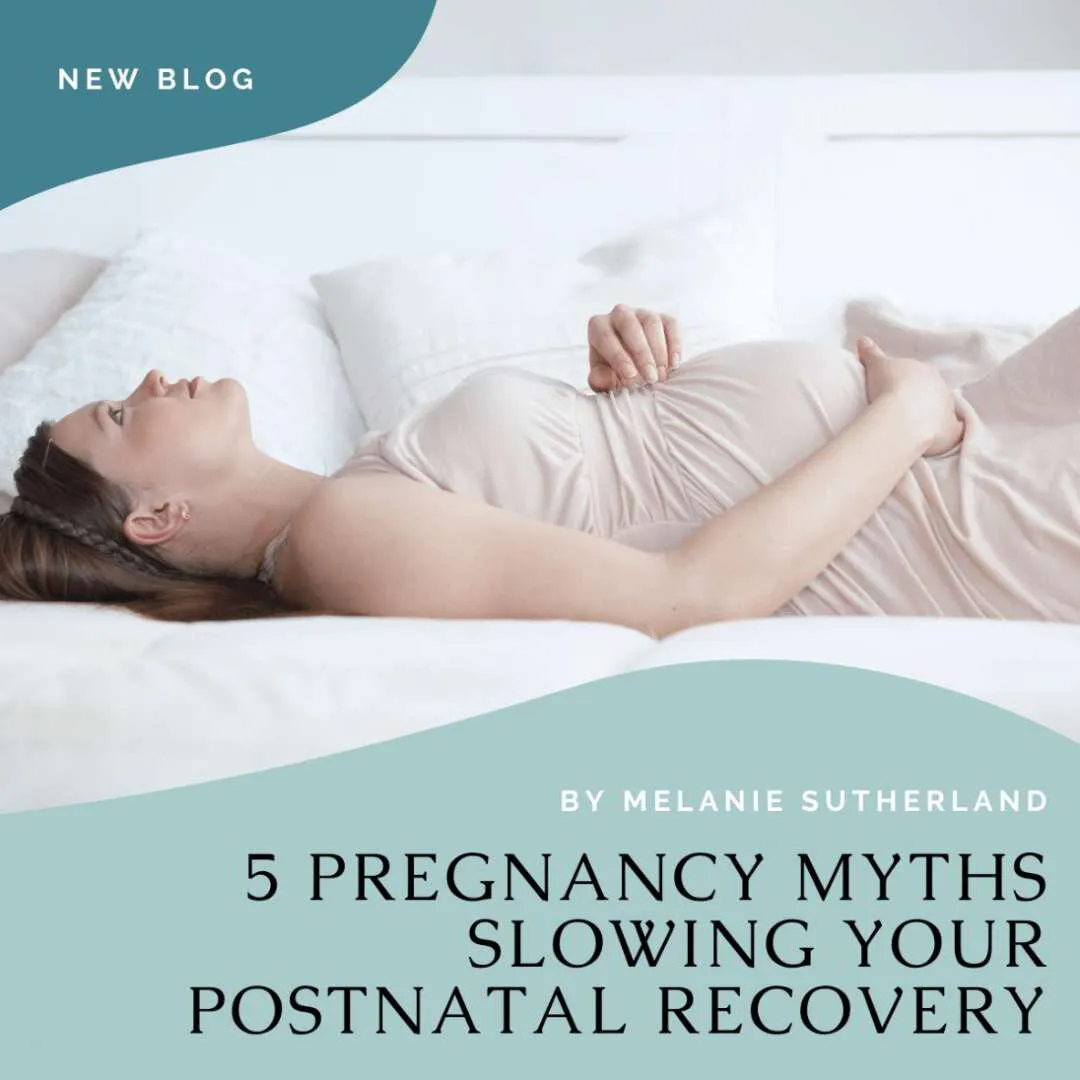We all know that person who gives you advice. They are usually the same person who reaches to pat your belly without asking first.
While generally well intended, most pieces of advice I’ve heard pertain to that individual’s experience and circumstances and have little foundation in science. So while they may have been helpful during their pregnancy, they could be at best irrelevant but potentially harmful to yours.
After 2 pregnancies and thousands of prenatal clients my advice has generally been to thank said well meaning person politely and then don’t give the information too much thought. What we know about pregnancy has come a long way. Guidelines have been rewritten and standards of care have changed often making the ancestral legacy of passed down advice outdated.
That being said, some of these tidbits may be getting in the way of you optimizing your pregnancy and accelerating your recovery. As such, it is important that we dispel some of the more common myths I hear on a regular basis.
Here are the top 5 pregnancy myths I think could use a bit of clarification:
Myth # 1 – Postnatal incontinence will go away on its own OR its a cost of motherhood.
Did you know that the bulk of my clients suffering from incontinence are not new mothers? In fact 96% of women who are incontent at 6 months will continue to be so at 5 years. That is precisely why this is such a dangerous assumption.
Your pelvic floor is a muscle. You would never tear or strain a bicep and say “well, I guess that is what I get for using my arm”. No, you would have imaging done, you would fret about it, you would see the appropriate health provider and come up with a plan of rehabilitation to fix it.
So why have we normalized women peeing their pants for years on end? Do you know what the number one reason for institutionalization is? It is incontinence. So why are we not more proactive about this or at least a little bit more upset?
Repeat after me:
Peeing your pants is not the cost of motherhood but it is a source of disengagement.
If you do not want to wear a panty liner or be terrified of a sneeze for the rest of your life, for the love of god, DO SOMETHING ABOUT IT. Start having the conversations that bring pelvic health into mainstream health discourse. Do the awkward uncomfortable thing now to avoid years of uncomfortable and awkward situations.
All women, without exception, should have a pelvic health physiotherapist as part of their perinatal team.
Myth #2 – Women who deliver via C-section do not experience pelvic floor dysfunction following birth.
A recent study followed 600 women for a five to ten year period after delivering their babies. When asked about pelvic floor symptoms including urinary incontinence, urge, frequency, back pain and dyspareunia (painful sex), the women who delivered vaginally reported higher instances of symptoms but a significant number of the c-section women also reported similar conditions. So while the common inference that a vaginal birth potentially increases the risk of pelvic floor dysfunction may have some relevance, the commonality between the two groups suggests that pelvic floor symptoms may be a result of pregnancy.
Moreover we know that the scarring associated with c-section, and often not well addressed, can also hinder pelvic floor healing and reduce mobility.
So to put it bluntly, no, a c-section does not absolve you of pelvic floor dysfunction but it also doesn’t mean you need to put up with it.
I highly recommend even if you know your c-section is going to be scheduled, have a pelvic floor consult during pregnancy as well as six weeks postnatally. Knowing the state of your pelvic floor and how to safely strengthen your core will go a long way toward reducing and managing pelvic floor symptoms.
------------------
Knowledge and preparation are power in pregnancy. We’ve come together with some of our community’s top perinatal practitioners to create the Thrive Pregnancy Bundle and bring you all of the discussions and information traditionally missing as women strive to thrive prenatally. 10 masterclasses, 13 resource guides and 7 tools and trackers all based in evidence, clinical experience and less than your monthly coffee spend. Get lifetime access to the bundle here.
------------------
Myth #3 – Not all women will experience abdominal separation (diastasis recti)
We used to think this was a matter of bad luck. We wrote it off to births of multiples, excessive weight gain or big babies. Current studies show that was just plain wrong. We know now that 100% of women will experience diastasis recti abdominus (DRA), a thinning and stretching of the connective tissue between your most superficial abdominal muscles.Think of it as needing to upgrade from a bachelor apartment to a two bedroom. That baby simply demands some extra space.
Now while there is nothing inherently wrong with abdominal separation, it is important we take it into consideration as part of the recovery plan. It is a disruption to the integrity of your core and can put you at risk for things like back and hip pain.
My recommendation is to have it checked postnatally to understand the degree of stretching and the underlying tone of the muscles that can help support your alignment. Work with someone who understands how changes associated with DRA can impact your function and who can prescribe a progressive return to activity program including modified positioning and exercises.
Myth #4 – All pregnant women should be doing kegels
This is potentially the biggest disservice by the perinatal community to our prenatal clients. For a while it was like hot sauce, we put that recommendation everywhere.
What current science and clinical experience says however is that women have varying degrees of pelvic floor tone and both ends of the spectrum can be exacerbated in pregnancy. On examination some women will display weak pelvic floors that could benefit from pelvic floor strengthening a.k.a. kegels (although real time ultrasound shows most women are doing them incorrectly). Conversely, many women exhibit increased tone or tight pelvic floors that can have their own host of issues including frequency, low back pain, painful periods and dyspareunia.
In the case of the tight pelvic floor, utilizing an exercise aimed at further tightening the pelvic floor can actually make symptoms worse therefore rendering it an inappropriate movement prescription.
In either case, the only true way to determine the tone (tightness or weakness) of the pelvic floor is through internal examination by a certified pelvic health practitioner. So the bottom line here is to avoid DIY’ing your prenatal core exercise program. Make sure you are properly evaluated by a professional and understand fully what exercises best meet your needs.
Myth #5 – Pregnancy should be a time of rest and relaxation
For a change, I don’t completely disagree with this recommendation. During pregnancy, especially the first trimester, the energy and nutritional demands on the mother to grow another human being can be overwhelming. It is important we listen to whispers from our body and rest where appropriate. The same is true for birthers with complications or contraindications.
Outside of those instances however, sometimes we like to stretch this idea a bit.
You would never run a marathon without training for it. It goes to reason that the more you do to prepare your body for not just delivery but also the increased demands of motherhood, the more comfortable the process will be. Maintaining muscle strength helps to support and counterbalance the weight of a growing baby. Regular movement helps buoy energy levels, maintain healthy digestion and improve sleep.
When it comes to prenatal movement, in 2018 the Society of Obstetricians and Gynaecologists of Canada made a recommendation that in the absence of contraindications, women should aim for 150 minutes of moderate to vigorous physical activity a week.
Ladies, pregnancy does not equal fragility. Strength can be powerful and is in the best interest of both the mother and baby on the same level as good nutrition, staying well hydrated and proper sleep. I highly suggest working with a prenatal exercise specialist if you are new to fitness or find an accountability partner to keep you moving through pregnancy.
Do I have you fired up? Good because that also means you are empowered and inspired.
So next time someone offers you a piece of folklore or unsolicited advice, thank them graciously and remain curious. Ask the right questions but ask them of the right people and communities. If you haven’t figured it out yet the only thing to come from an internet mommy chat room is anxiety and worry.
You deserve to thrive in pregnancy, not simply survive.
+Melanie Stevens Sutherland, Clinic Director & Senior Orthopaedic and Pelvic Floor Physiotherapist
Melanie is a graduate of McMaster University and brings 20+ years of experience as a senior physiotherapist to Body Co. She has enjoyed a long tenure working with active populations at prestigious sport medicine clinics. Past clients include Provincial, National and Olympic level athletes as well as members of the National Football League, the Canadian Football League, the Ontario Hockey League, the American Hockey League, the National Lacrosse League and Major League Soccer.
Following the birth of her own children, Melanie developed a strong interest in women’s health. She has taken specialized courses in pelvic floor physiotherapy and women’s nutrition. She is passionate about helping women find strength and confidence in their post-natal bodies following pregnancy and delivery.
If you have enjoyed this blog and would like to learn more about health and wellness from our team of expert practitioners, follow us on Facebook and Instagram.


